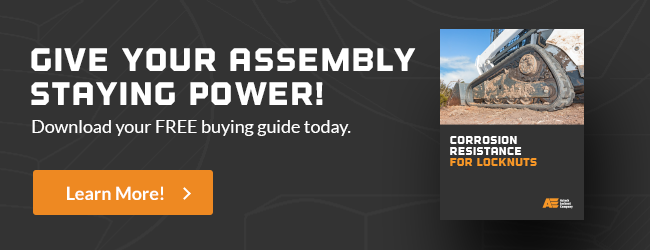
When choosing the right locknut and coating for your assembly, there are many things to consider. One common concern is hydrogen embrittlement. But what exactly is hydrogen embrittlement, how can a locknut be compromised due to this, and how can you stop it?
The Problem
Hydrogen embrittlement is a form of corrosion that weakens locknuts and may cause them to crack when under heavy loads. A locknut can only be subject to hydrogen embrittlement if the process used to apply the plating or coating will generate hydrogen by interacting with the metal. Acid pickling, electroplating, and high pressure steam all have the potential to weaken a piece due to excess hydrogen produced.
There are three types of hydrogen embrittlement that can damage locknuts: internal, environmental, and hydrogen chemical reaction.
Types of Embrittlement
Internal Hydrogen Embrittlement
This type of hydrogen embrittlement occurs most frequently when hydrogen is absorbed by the piece before plating. Then it is trapped under the plating and remains even through the baking process. There would be no indication during proof testing. However, once pressure is applied to the piece, it fails at points of high stress. This can either create or extend existing cracks until the locknut breaks.
Environmental Hydrogen Embrittlement
Environmental embrittlement is an infrequent problem. It can only occur if the piece is under stress in a high-pressure hydrogen environment. A possible scenario for this type of corrosion would be in a hydrogen storage tank.
Hydrogen Chemical Reaction
There are two chemical reactions that can be dangerous. The first type occurs when hydrogen in the environment reacts with carbon, creating methane gas. This can quickly reduce strength of a piece or cause cracks. The second type is when hydrides are formed that are not as strong as the parent alloy.
Combatting Hydrogen Embrittlement
1. Avoid high concentrations of hydrogen. Electroplating is one process that uses an acid to clean the piece. While effective, the longer a piece is exposed to acid and the higher the concentration of hydrogen, the more likely the piece is to experience this type of corrosion. Many dip-spin coatings provide a hydrogen embrittlement “free” solution. The mechanical process of abrasive blasting for descaling helps reduce the chance of embrittlement.
2. Coating porosity. Less dense coatings are less likely to seal or trap hydrogen under the coating.
3. Baking standards. It appears that the chance for hydrogen embrittlement is greater, the longer a piece is left after plating before it is baked. Most standards now require locknuts to be baked before 2 hours have passed from the time of plating.
With the proper attention to detail most hydrogen embrittlement can be avoided. Talk to a professional to see what kind of coating and what type of application process would work best for your piece.
Aztech offers a variety of coatings and application options to help you combat hydrogen embrittlement. Learn more about choosing a coating in our buying guide, “Corrosion Resistance for Locknuts” or talk to a representative today.
Resources:
Barrett, Rich. "Fastener Design Manual, Part One." The Engineer's Companion. N.p., 14 Nov. 2008. Web. 14 Dec. 2016. <http://www.designnotes.com/companion/manual-1.html>.
"Embrittlement." Embrittlement _Feb-26-09_.doc. Fastenal Engineering and Design Support, 26 Feb. 2009. Web. 14 Dec. 2016. <https://www.fastenal.com/content/feds/pdf/Article%20-%20Embrittlement.pdf>.
Industrial Fasteners Institute. Identifying Hydrogen Embrittlement Failures. N.p.: Industrial Fasteners Institute, 2001. Product_Specifications_05. Industrial Fasteners Institute, Aug. 2001. Web. 14 Dec. 2016.




